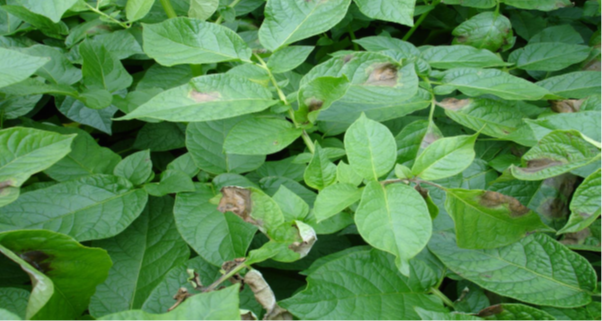Blight proves challenging in 2019
30 August 2019Perhaps an early warning of things to come
At SRUC’s potato blight trial site this year blight has proven to be particularly difficult to control since the start of August. Of course, the weather has been highly favourable for blight, with prolonged high-risk conditions which combine warm temperatures and with high relative humidity. However, these conditions are not so unusual and we encountered such conditions in many previous years without seeing the same severity of blight. So it is concerning that disease is so severe in trial plots, and it is possible that other factors which longer-term implications may be responsible.
There are three obvious differences in the 2019 season. The higher than average air temperatures and high-intensity rainfall will have contributed substantially to the epidemic on the SRUC Auchincruive Estate where the trials are located. For example, blight risk is higher at an average temperature of 21oC compared with temperatures of 16oC. In addition, the rain-fastness of fungicide products will have been very thoroughly tested this season so could be a factor although, again, we have had similar conditions before so the wet end to July and poor August weather doesn’t explain away the unusual severity.
That leaves a final and worrying possibility to explain the unusual severity. It could be that the third difference in 2019 may be the most significant. Samples of P. infestans from the site have recently been genotyped by the James Hutton Institute and there is mainly natural infection by the new genotype 36_A2. Information to date indicates that this genotype is associated with high aggressiveness. This confirmed presence of 36_A2 at the site may explain, at least in part, why the general level of control at the site just recently has not been as good as anticipated. There is no evidence from the trial site of any fungicide resistance issues although this will be further tested.
It is important to raise awareness that new more aggressive strains of blight are present in Scotland and might be making their presence felt, although it is too early to state definitively that 36_A2 will make blight control more difficult in crops in future. This is because it is impossible to separate out the individual effects of the number of blight risk Hutton periods, the amount of rainfall, the higher air temperatures and the P. infestans genotypes present. That said there is a suspicion that we may be at the start of another step-change in P. infestans aggressiveness in Scotland. There are strong similarities to 2007, a bad year for blight when genotype 13_A2 started to have a considerable impact on the effectiveness of blight control measures. For this season, keep blight programmes tight and mix and alternate actives making full use of multi-sites, to minimise the risks of blight getting into crops, or of resistant strains being favoured.
Ruairidh Bain and Fiona Burnett, Scotland’s Rural College for the Farm Advisory Service
Sign up to the FAS newsletter
Receive updates on news, events and publications from Scotland’s Farm Advisory Service

